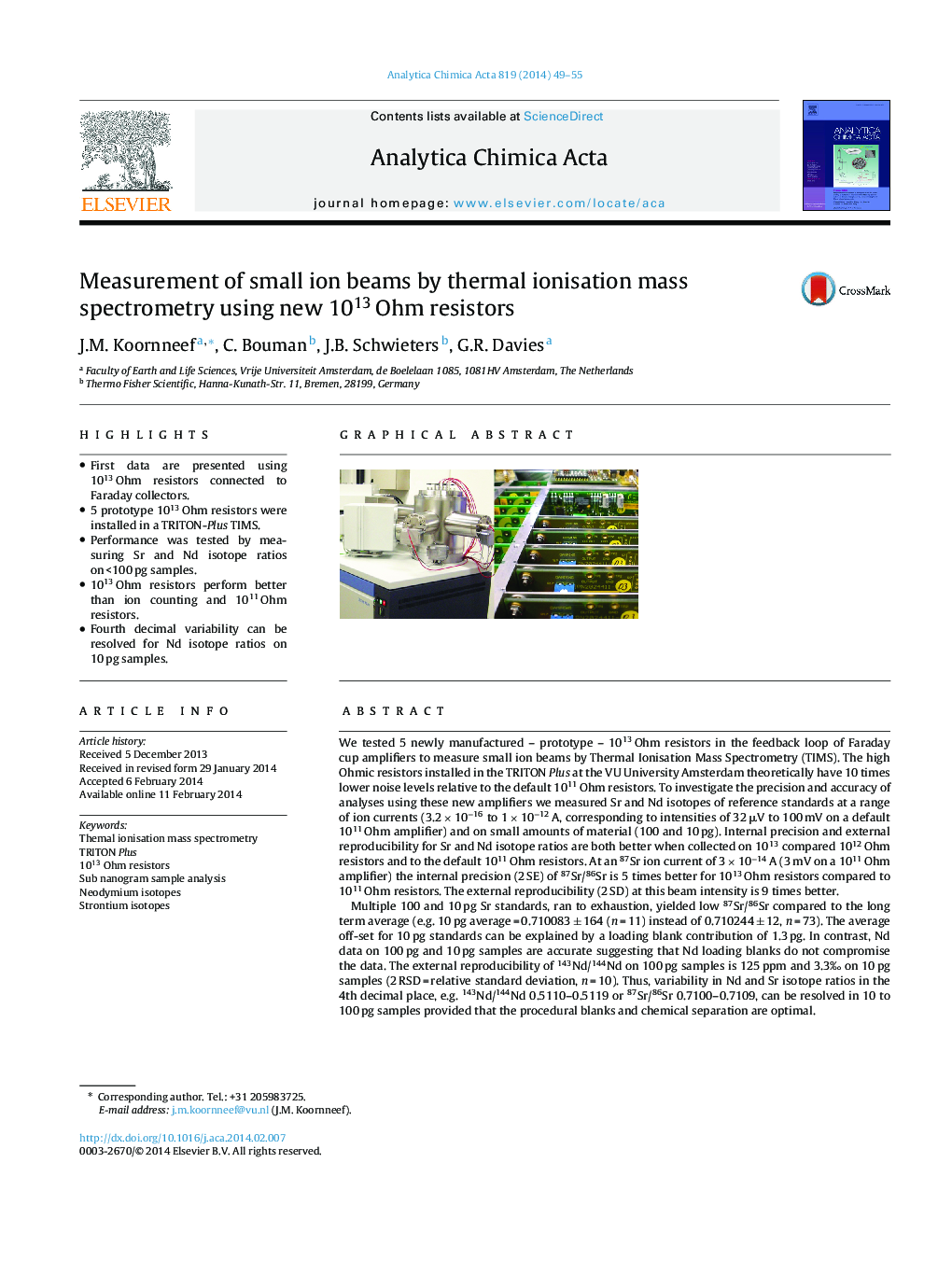| کد مقاله | کد نشریه | سال انتشار | مقاله انگلیسی | نسخه تمام متن |
|---|---|---|---|---|
| 1163991 | 1491013 | 2014 | 7 صفحه PDF | دانلود رایگان |

• First data are presented using 1013 Ohm resistors connected to Faraday collectors.
• 5 prototype 1013 Ohm resistors were installed in a TRITON-Plus TIMS.
• Performance was tested by measuring Sr and Nd isotope ratios on <100 pg samples.
• 1013 Ohm resistors perform better than ion counting and 1011 Ohm resistors.
• Fourth decimal variability can be resolved for Nd isotope ratios on 10 pg samples.
We tested 5 newly manufactured – prototype – 1013 Ohm resistors in the feedback loop of Faraday cup amplifiers to measure small ion beams by Thermal Ionisation Mass Spectrometry (TIMS). The high Ohmic resistors installed in the TRITON Plus at the VU University Amsterdam theoretically have 10 times lower noise levels relative to the default 1011 Ohm resistors. To investigate the precision and accuracy of analyses using these new amplifiers we measured Sr and Nd isotopes of reference standards at a range of ion currents (3.2 × 10−16 to 1 × 10−12 A, corresponding to intensities of 32 μV to 100 mV on a default 1011 Ohm amplifier) and on small amounts of material (100 and 10 pg). Internal precision and external reproducibility for Sr and Nd isotope ratios are both better when collected on 1013 compared 1012 Ohm resistors and to the default 1011 Ohm resistors. At an 87Sr ion current of 3 × 10−14 A (3 mV on a 1011 Ohm amplifier) the internal precision (2 SE) of 87Sr/86Sr is 5 times better for 1013 Ohm resistors compared to 1011 Ohm resistors. The external reproducibility (2 SD) at this beam intensity is 9 times better.Multiple 100 and 10 pg Sr standards, ran to exhaustion, yielded low 87Sr/86Sr compared to the long term average (e.g. 10 pg average = 0.710083 ± 164 (n = 11) instead of 0.710244 ± 12, n = 73). The average off-set for 10 pg standards can be explained by a loading blank contribution of 1.3 pg. In contrast, Nd data on 100 pg and 10 pg samples are accurate suggesting that Nd loading blanks do not compromise the data. The external reproducibility of 143Nd/144Nd on 100 pg samples is 125 ppm and 3.3‰ on 10 pg samples (2 RSD = relative standard deviation, n = 10). Thus, variability in Nd and Sr isotope ratios in the 4th decimal place, e.g. 143Nd/144Nd 0.5110–0.5119 or 87Sr/86Sr 0.7100–0.7109, can be resolved in 10 to 100 pg samples provided that the procedural blanks and chemical separation are optimal.For measurements in the beam intensity range usually covered by ion counting (<3 mV or 2 × 105 cps) we obtain a 143Nd/144Nd internal precision (2 SE) of 480 ppm for a 143Nd intensity of 6.25 × 104 cps (1 mV) and 1% at an intensity of 2 × 103 cps (32 μV on a 1011 Ohm amplifier). We find that at intensities higher than 2 × 104 cps the precision using the 1013 Ohm resistors is better than for ion counting owing to instability and non-linearity behaviour of the ion counting system. Our results indicate that between 2 × 104 cps and an ion current of 2 × 10−13 A (20 mV on a 1011 Ohm amplifier) it is beneficial to use the high gain amplifiers instead of (multi) ion counting or Faraday cups equipped with the standard 1011 Ohm resistors. This finding suggests that the newly developed high gain resistors could potentially be valuable in applications that currently use (multiple) ion counting to measure small ion beams (e.g. U-series, Re-Os, Pu, Pb). In addition to improved precision, the use of Faraday cups equipped with high resistance amplifiers is more practical in terms of the required calibration procedure and in the flexibility in the collector set-up compared to using multiple ion counting arrays.
Figure optionsDownload as PowerPoint slide
Journal: Analytica Chimica Acta - Volume 819, 28 March 2014, Pages 49–55